 |
BRIONVEGA mod. TS-502 V2G - Italy - 1970 |
 |
|
|
Italiano
|
||
|
The Italian architect Marco Zanuso and the German designer Richard Sapper designed the TS502 cabinet in 1962 and the radio called "Radio Cubo" due to its shape, was built and marketed by from the Brionvega company in Milan starting from 1964. The radio was produced with a plastic cabinet of various colors and due to its revolutionary design this device has remained an important point of reference in the field of industrial design. A copy of the TS-502 is exhibited in the most important modern art museums, such as the Museum of Modern Art in New York where it can be admired together with the Brionvega portable television mod. Algol 11". This radio receiver, like other equipment made by Brionvega, has become a cult object and is highly sought after by collectors. The TS-502 has two reception bands: Medium Wave and Frequency Modulation. In essence, two separate receivers coexist in the radio which share the audio amplifier stage. Various cube models have been produced over the years, the example in my collection is a TS-502 V2G which has been on the market since 1970. As active elements in the TS-502 V2G are used eight silicon transistors (3 x BF194, 3 x BF195, 2 x BC148), four germanium transistors (AF125, AC194, AC193, OC75) and an SO41P integrated circuit which acts as an intermediate frequency amplifier in the FM receiver.r. The radio is shaped like a double cube and is made up of two sections made of ABS plastic. The two boards with the AM and FM receivers are included in the right section, while the audio circuit, the speaker and the battery compartment are in the left cube. The connection cables between the two sections pass through the hinges, equipped with special grooves. When closed the radio has the shape of a rounded parallelepiped. Once opened, the two sections rotate on the hinges and are joined on the internal sides thanks to a small magnet. The speaker is a 4 inches diameter IREL (Industrie Radio Elettriche Liguri S.p.A., Genova-Italia) which together with the well-sized amplifier stage produces a "warm" and truly pleasant sound. Power is provided by 6 x 1.5 Volt batteries (type C or R14) for a total of 9 V. The dimensions are: 9.055 x 5.118 x 5.118 in, and the weight is 3lb 14.85 oz without batteries.
© IK3HIA, 2007 |
|||
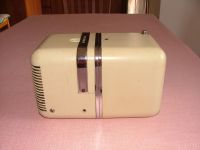 |
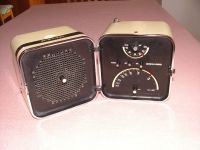 |
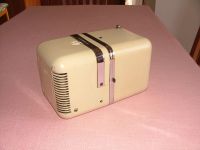 |
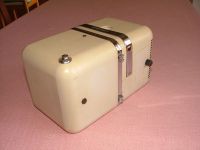 |
|
Click on images to enlarge
|
|||
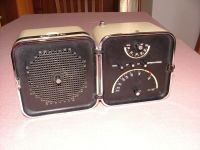 |
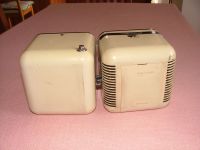 |
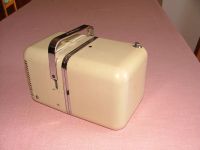 |
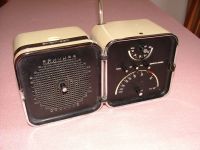 |
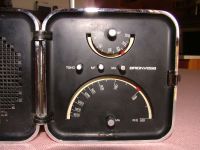 |
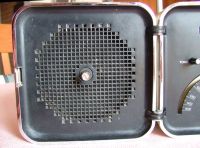 |
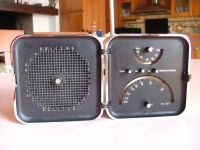 |
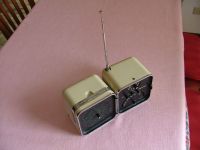 |
|
L'architetto italiano Marco Zanuso e il designer tedesco Richard Sapper progettarono il mobiletto della TS502 nel 1962 e la radio, denominata "Radio Cubo" per la sua forma, fu costruita e commercializzata dalla ditta Brionvega di Milano a partire dal 1964. La radio veniva prodotta con il mobiletto di plastica in vari colori e per il suo disegno rivoluzionario questo apparecchio è rimasto un importante punto di riferimento nel campo del design industriale. Una copia della TS-502 è esposta nei più importanti musei di arte moderna, come ad esempio il Museum of Modern Art in New York dove lo si può ammirare assieme al televisore portatile della Brionvega mod. Algol 11". Questo ricevitore radio, come del resto le altre apparecchiature realizzate dalla Brionvega, è diventato oggetto di culto ed è molto ricercato dai collezionisti. La TS-502 ha due bande di ricezione: le Onde Medie e la Modulazione di Frequenza. In sostanza nella radio convivono due ricevitori separati che hanno in comune lo stadio amplificatore Audio. Nel corso degli anni sono stati prodotti vari modelli di cubo, l'esemplare nella mia collezione è una TS-502 V2G che è stata commercializzata dal 1970. Come elementi attivi nella TS-502 V2G vengono utilizzati otto transistor al silicio (3 x BF194, 3 x BF195, 2 x BC148), quattro transistor al germanio (AF125, AC194, AC193, OC75) e un circuito integrato SO41P che funge da amplificatore a Frequenza Intermedia nel ricevitore FM. La radio ha la forma di un doppio cubo ed è composta da due sezioni realizzate in plastica ABS. Le due schede con i ricevitori AM e FM sono comprese nella sezione di destra, mentre il circuito Audio, l'altoparlante e il vano batterie sono nel cubo di sinistra. Nelle cerniere, dotate di apposite scanalature, passano i cavi di collegamento fra le due sezioni. Quando è chiusa la radio ha la forma di un parallelepipedo arrotondato. Una volta aperta, le due sezioni ruotano sulle cerniere e si uniscono sui lati interni grazie a una piccola calamita. L'altoparlante è un IREL (Industrie Radio Elettriche Liguri S.p.A., Genova-Italia) da 10 cm di diametro che assieme allo stadio amplificatore ben dimensionato produce un suono "caldo" e veramente gradevole. L'alimentazione è fornita da 6 batterie da 1,5 Volt (tipo C o R14) per un totale di 9 V. Le dimensioni sono: 23 x 13 x 13 cm, e il peso e' di 1,782 kg senza batterie.
© IK3HIA, 2007 |
|||
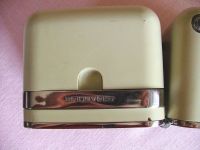 |
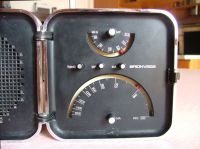 |
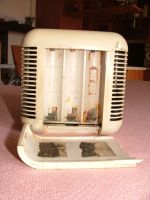 |
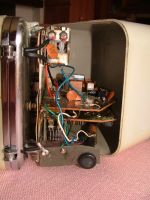 |
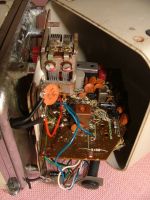 |
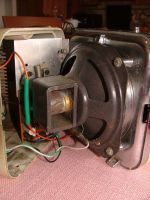 |
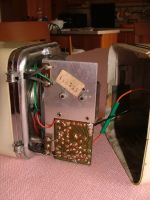 |
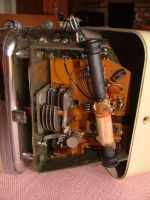 |
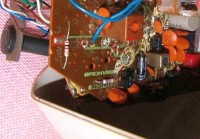 |
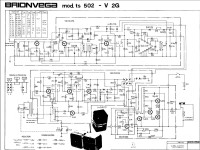 |
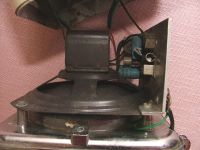 |
|
| Return
to top of page
|
|||
|
|
|||
|
|
Return to: IK3HIA home page |
|
Return to: Transistor Radio |
|
Go to: Transistor diagrams |